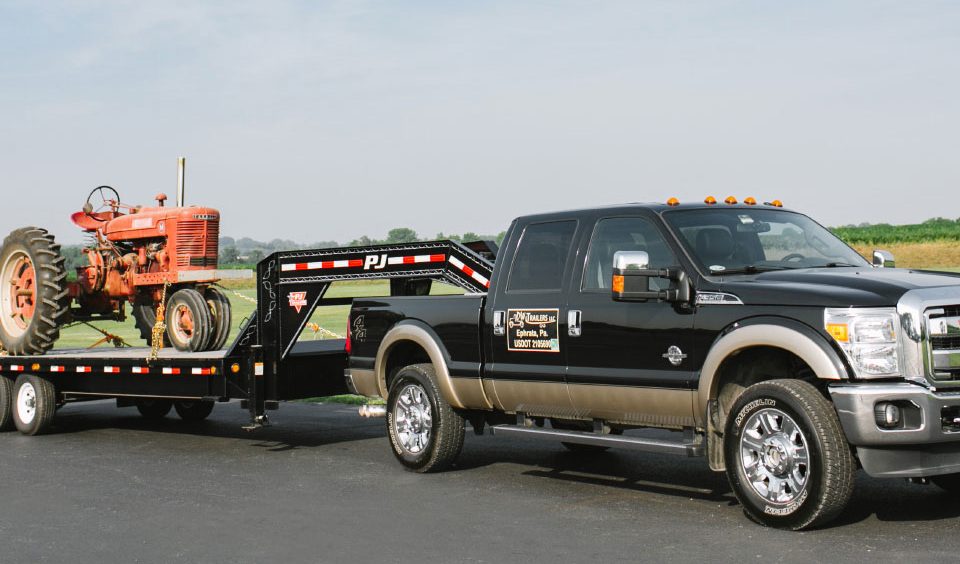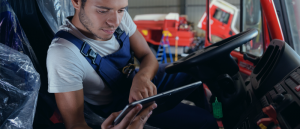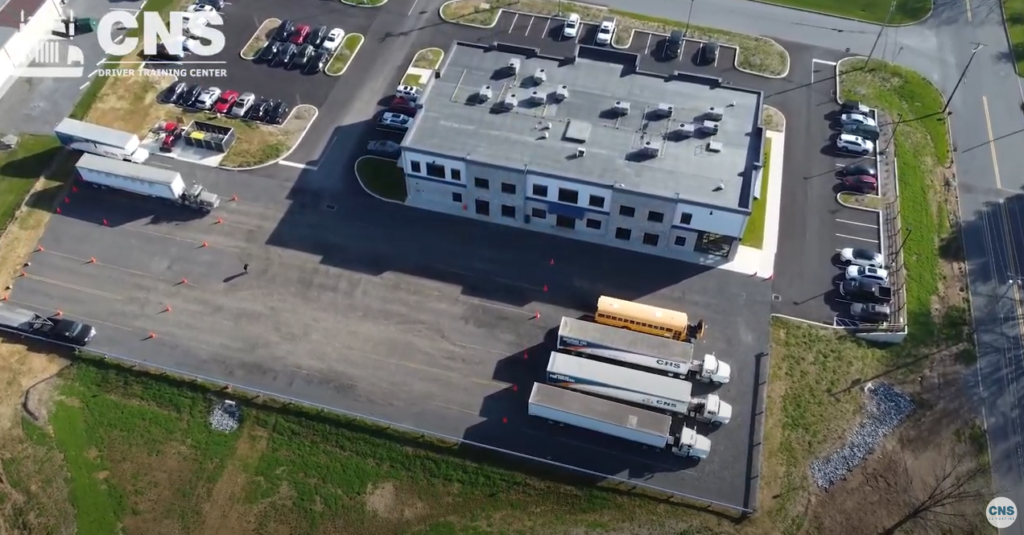Hotshot trucking is often associated with commercially driving an F-350 and pulling a gooseneck or 5th wheel trailer to haul construction materials, cars, sheds, horses, etc.
Hotshot freight is simply hauling for a single customer that is needed in expedited fashion.
We often see farmers hauling equipment for personal use that want to take the next step to hauling commercially for customers. In other cases, a driver wants to be their own boss but worries about going into debt from purchasing a big rig.
You Can Receive Out-of-State CDL Training with Home State CDL Permit
The question we hear most often is “Do I need a CDL for Hotshot?”
According to regulations, a commercial driver’s license is not required in many states until you are driving vehicles commercially over of 26,000 lb. In some states a CDL is required for vehicles weighing more than 10,000 lb.
If you are looking to get started, below are 5 reasons why we recommend getting your CDL when hauling hotshot versus non-CDL hotshot.
REASON #1: CDL hotshot drivers have flexibility and a back-up plan
Many who enter the hotshot business want flexibility.
If you are looking to haul commercial loads, it is easier to get hired anywhere with a Class A CDL. A clean driving record and a CDL gives your hotshot business a starting point to build your reputation as well as your customers.
If you are driving hotshot as a steppingstone to bigger things, then hauling hotshot with no CDL is not worth it because you do not have a back-up plan. With a CDL, you can start your business driving smaller hotshot loads locally that might not need a CDL to haul.
If you are not making enough money this way, you can move up to a larger vehicle or 40-foot trailer for bigger and more lucrative loads and haul interstate across state lines. If this is not enough, you can step up to a semi or be a company driver.
Basically, without the CDL, you are stuck hauling smaller local freight, and it will be harder to grow your business and ultimately harder to make more money.
REASON #2: Drive any vehicle over GVWR 26,000 lbs and pull a trailer with GVWR over 10,000 lbs
Hotshot haulers quickly find out the importance of understanding gross vehicle weight ratings (GVWR). The size of your truck limits the size of your trailer and ultimately limits the size of the load you can haul and the revenue you can earn.
Generally, commercial motor vehicles (CMVs) are defined as vehicles engaged in interstate commerce (crossing state lines) and:
- Weighing (including any load) more than 10,000 lbs, or
- Having a gross vehicle weight rating or gross combination weight rating of more than 10,000 lbs, or
- Transporting hazardous materials in a quantity requiring placards
As a hotshot your CMV can be a cut-away van, medium-duty box truck, a smaller F-250 or equivalent truck to a larger F-450/550 Super Duty or equivalent for towing. All of these vehicles differ in weight, which in turn affects the size of load you can haul.
Similarly, hauling hotshot can have a variety of trailers that are suitable for the types of loads you plan to carry. There can be smaller horse trailers, flatbed trailers, or larger 30 to 40-ft gooseneck trailers. These too differ in weight and affect the size of loads you can haul.
Remembering the regulations, if the GVWR of your truck, trailer, and cargo is greater than 26,000 lbs, then you need a CDL. Similarly, if you are towing, including the trailer weight, greater than 10,000 lbs, you need a CDL.
A CDL gives you the flexibility to haul different size loads with different equipment and vehicles needed for the types of loads you plan to carry.
REASON #3: No limitations on hotshot loads
Now that you understand the importance of GVWR, we can now talk about the economics of hotshot trucking without a CDL.
Simply, if you do not have a CDL, the max weight must be 26,000 lbs or less. If you have an F-350 that weighs 10,100 lbs and a trailer that weights 7,000 lbs empty, then this only gives the non-CDL hotshot the ability to haul a maximum of 8,900 lbs.
26,000 (max weight without CDL)
– 17,100 (weight of truck + trailer)
= 8,900 (max load for non-cdl)
If you have a CDL, you can haul over that 26,000 GVWR limit.
But let us take this a step further.
If you use a 2500 truck with a GVWR of 10,000 lbs and a tandem axle single wheel with 14,000 lbs GVWR, then the combination is rated and licensed for 24,000 lbs.
Empty weight is 14,560 lbs with fuel, luggage, and you in the cab. This means of the 24,000 lb rating minus 14,560 lbs empty is 9,440 pounds of cargo you can haul.
However, the rear axle is rated for 6,200 lbs and the trailer axles are rated at 7,000 each. That is a 22,000 lb design limitation, which you never want to exceed.
The trailer tongue adds 1,940 lbs of empty weight to the rear axle, which scales 3,200 lbs empty with no trailer and 5,140 lbs with an empty trailer.
So, 6,200 lbs minus 5,140 lbs means you can add 1,060 lbs to the tongue before exceeding the trucks design limits.
This is why it is imperative to know how much your cargo weighs and know where to put it on the trailer. If you do not have a CDL, you have fewer equipment and load options to make money.
REASON #4: Gain more driving experience without expensive CDL schools
Whether you are looking to get a CDL or not, hotshot drivers do not need to go to an expensive big rig CDL school to be trained.
CDL trucking schools are focused on training semi-truck drivers and the federal regulations surrounding them. Much of the knowledge learned at these schools are not needed for hot shot drivers.
Landscapers, construction workers, small car haulers, and other hotshot haulers can be trained to drive an F-250 with a goose neck and a 30-foot trailer to get their CDL with no endorsements or restrictions instead of spending $5000-$8000 on CDL trucking schools driving a big rig.
The best way to get comfortable hauling hotshot is to learn 1-on-1 with training tailored to your needs and experience.
CNS Driver Training Center in Lititz, PA offers very affordable CDL hotshot training geared towards aspiring drivers who are looking to get their CDL quickly, outside of a traditional CDL school.
You Can Receive Out-of-State CDL Training with Home State CDL Permit
Our trainers are fully qualified to train you on any equipment you use while also offering our F-250 with automatic transmission and a 30-foot gooseneck trailer.
We will train you to have your Class A CDL so that you are able to drive any vehicle with a GVWR of 26,001 pounds or more and pulling a trailer that has a GVWR of 10,001 lbs or more.
We can customize any training package to your needs and skill level.
Want to talk to a DRIVING INSTRUCTOR about CDL TRAINING?
REASON #5: Avoid DOT fines: Licensing requirements for a new CDL hotshot
We talked a lot about GVWR and the importance of understanding weight regulations. If you are hauling overweight of the regulations or vehicle designed ratings, DOT inspectors can quickly fine you during a roadside inspection at the scales.
However, hotshot drivers must worry about other DOT regulations and licensing requirements. If you do not meet any of these requirements, it will be easy for DOT auditors to fine your company.
Starting any business can be expensive and time consuming.
When it comes to licensing your hotshot, CDL fleets need a USDOT number, driver files, drug and alcohol consortium, MC number, BOC-3, UCR, and more depending on what you plan to be hauling.
If your maximum operating gross weight does not exceed 26,000 pounds, there is no requirement to have an IFTA (International Fuel Tax Agreement) sticker or IRP (International Registration Plan) plates.
You will, however, need to obtain commercial license plates from your home state.
As a new hotshot, you will need the following documents:
- Business License
- Vehicle documents, including title and registration
- Proof of Insurance
- Vehicle for Service Permit
- USDOT number required for interstate hauling
- Operating Authority (MC) obtained with the USDOT
- Commercial Driver’s License (highly recommended)
- Papers of incorporation of LLC status
Does this seem overwhelming? Don’t worry, CNS is here to help. Our CNS Driver Training Center is a subsidiary of Compliance Navigation Specialists, a company considered to be industry experts when it comes to DOT Compliance.
Our DOT compliance specialists take the time to learn about your operation and will let you know what you need to be completely DOT compliant.
We are here to assist with all DOT compliance and licensing needs, including DOT medical services, DOT audit services, DOT safety rating upgrades, IFTA fuel tax reporting, starting a trucking company and more.
For more information, contact us at 888.260.9448 or info@cnsprotects.com








